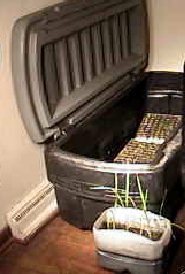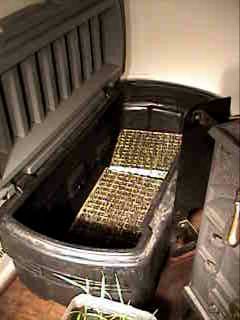 Rice Cultivation
Rice Cultivation
2002, 2003, 2004 2005 Updates
 Rice Cultivation
Rice Cultivation
2002, 2003, 2004 2005 Updates
If I had 20 years of experience, then this page would not be necessary. But, I am new to rice cultivation. My first growing season was 2001. As time goes on, I hope to learn more and to provide better information. I would love to see this evolve into a repository of rice growing experiences, from around the world! So, please feel free to share your own observations and opinions. This page is devoted to innovations, modern & ancient, as we enter the 2002 season, and beyond....
They say a picture is worth a thousand words! In this case, they are correct. Here's a photograph of the starter flats, floating in their container of water.

In SW Ohio, late April and early May have been cool and rainy, so germination has taken place indoors, in a warm corner of the house. The watertight container, housing the floating flats, is small enough for two people to carry outside. Germination under the sun is preferable and the container provides some helpful options. We can lower the lid when it rains. And we can close the lid completely, to retain heat on cool nights.
Only a fanatic would be attracted to having the big germination box in their living room! But, there are other options. Check out the little white box in front of the big container. That, my friends, is quite possibly the smallest rice paddy you will ever see.
In March, I was curious to find if the seeds from my 2001 garden were viable; if they could produce another generation of rice. Instead of using floating flats, I filled four, 3 inch pots (the kind used for starting flowers or tomatoes) with a 50%- 50% mix of peat and vermiculite. I placed the pots in a regular, plastic starter flat.
I kept the mix warm and very moist (adding warmed spring water to the flat) and the rice germinated very well. When the seedlings were about 5 inches tall, I cut a 2 1/2 gallon spring water container in half (that's the little white box) and filled it a little over half way, with a 50%-50% mix of purchased topsoil and compost. I carefully removed the seedlings from the pots, keeping as much mix as possible attached to the roots, and I eased them into the topsoil. Then, I filled the paddy with warm spring water until the water level was about 1 inch above the soil.
It took the seedlings about 1 week to begin to anchor their roots in the new soil. During that time, the first batch of water had become green from algae, so I emptied the paddy, using a small cup. Of course the soil remained moist. I waited for one day and then added a new batch of water. It has remained fairly clear, ever since.
On warm, dry days, the "mini-mini" paddy spends the day in the sun. Eventually, it will remain outdoors, for good. I mention this for those who live in cities and apartments; especially if you have a balcony. You could substitute the spring water container with a more elegant pot. Any pot will do, so long as there are no drain holes in the bottom. Decorative pots are available at any garden supply store.
For the ultimate mini-paddy, a ceramic pot would be excellent. Since the pot must hold standing water, I would avoid porous terra-cotta and find a more vitreous pot. Unless you are sure of the source, avoid glazed pots. Most food-related pottery is produced with lead free glazes. I doubt that the same caution is applied to flower pots.
The total cost of my humble mini-mini paddy was less than a dollar and I hope to enjoy it all summer.
Prior to that experiment, I tried starting the rice in Jiffy® pellets in an electrically heated Jiffy® flat. Germination was very slow, and I don't recommend it. I don't think that rice requires light to germinate, but it certainly requires light soon after it has sprouted. In my case, the Jiffy® flat was sitting on a cold floor. Possibly, you could have better luck in a warmer area.
Here's a closer view of the water container and the Styrofoam floating flats:

When we first plant and load the flats, we don't need much water in the bottom of the container. Maybe 5 inches, or so (12 or 13 centimeters). Less water means less weight, so the box is easy to carry around. It also leaves room for more water, which is very useful later in the spring, when the box has been relocated outside. If the forecast indicates a cold night, I can add a gallon of warm water and close the lid until morning.
Here's a little guy, just waking up:

The seedlings look like tiny green hairs, at first, but they grow rapidly. Growth is directly related to heat and light. In 2001, the seedlings were 6 inches tall and ready to transplant in an amazing 12 days! This season, I planted the seedlings on May 6*. The pictures were taken on May 12. It is now the 17th, so 11 days have passed. The rice is doing well but, unlike last year, they have not been outside for a single day (unseasonably cloudy and cool). So, they are growing a bit slower than in 2001.
* I did not float-test the 2002 rice, prior to planting the seeds. I was confident that I would have strong germination. As an afterthought, I am sorry that I skipped the test. I think that the initial immersion in water helps the seeds to germinate faster. For more information on float testing, see the "Germination" notes in the original article.
Also, they are thinner. I wouldn't say they are weak, but they certainly could use 4 or 5 days of sun. I want to plant them directly in the garden soil and then germinate another batch for planting in the paddies. I have a little extra time for the second batch, because the rice grows much faster in paddies.
In any case, if the weather doesn't break soon, all I will be able to do is plant this first group in the mud and hope for the best! I'll keep you posted.
You can watch the rice grow in the photo updates, below.
Photo Update- September 3, 2002
Photo Update- October 16, 2002
Building a Traditional Rice Paddy
A very interesting, step-by-step example of traditional paddy construction, from the PBS "Nova" television series.
Wayne Weber is an international construction consultant, software designer and web master. To maintain some semblance of sanity (?), he writes 9 Star Ki publications, makes artwork in his little studio near Blooming Grove, Indiana, and mucks about in The Garden.